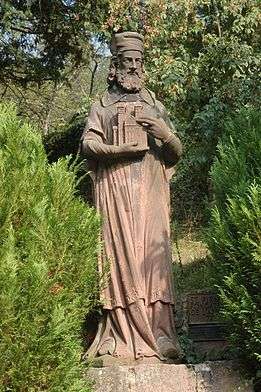Saint Pirmin
| Saint Pirmin | |
|---|---|
|
Late medieval figure of Saint Pirmin at Murbach Abbey | |
| Born |
700 somewhere in Spain |
| Died |
November 3, 753 Hornbach, Germany |
| Venerated in |
Roman Catholic Church Eastern Orthodox Church Anglican Church? |
| Feast | November 3 |

Saint Pirmin (ca. 700 - Hornbach 753),[1] also named Pirminius, was a monk, strongly influenced by Celtic Christianity and Saint Amand.
Biography
He originated from the surroundings of Narbonne, possible of Visigothic origin,[1][2] many of whom had to flee to Francia after the conquest of Spain by the Saracens in the beginning of the 8th century.[3]
From 718 onwards, he was abbot of the monastery Quortolodora in Antwerp (Austrasia) [4] and, together with its pupils, the minister of the church inside the broch, het Steen. In the 12th century, this church was dedicated to Saint Walpurga. After a while Pirmin was invited by count Rohingus to stay at his villa in Thommen, near Sankt Vith in the Ardennes.
Pirmin gained the favour of Charles Martel. He was sent to help rebuild Disentis Abbey in Switzerland. In 724, he was appointed abbot of Mittelzell Abbey at Reichenau Island, which he had founded.[1] For political reasons he was banished to Alsace. In 753, he died in the abbey at Hornbach, where his body is entombed.
Missionary and other activities
Pirmin's missionary work mainly took place in the Alsace and the upper area of the Rhine and the Danube. Besides actively preaching and converting, he also founded or reformed many monasteries, such as those at Amorbach, Gengenbach, Murbach, Wissembourg, Marmoutier and Neuweiler. Pirmin secured endowments from area nobility: Odilo of Bavaria financed the foundation of Niederaltaich Abbey,[3] Werner I of what became the Salian dynasty endowed the new abbey at Hornbach.
The most important of Pirmin's books is Dicta Abbatis Pirminii, de Singulis Libris Canonicis Scarapsus ("Words of Abbot Pirminius, extracts from the Single Canonical Books").[5] The book collects quotations from Church Fathers and scriptures, presumably for use by missionaries,[1] or reading during monastic meals. Written between 710-724, it contains the earliest appearance of the present text of the Apostles' Creed.[6]
References
- 1 2 3 4 Old, Hughes Oliphant (1998). "3". The reading and preaching of the scriptures in the worship of the Christian church. Wm. Eerdmans. pp. 137–40. ISBN 978-0-8028-4619-8.
- ↑ Jecker, Gall (1927). Die Heimat des hl. Pirmin des Apostels der Alamannen. Aschendorf.
- 1 2 Fletcher, Richard A. (1999). The barbarian conversion: from paganism to Christianity. University of California Press. pp. 203–204. ISBN 978-0-520-21859-8.
- ↑ "De ecclesia in Antweppo (sic) castello" by Theodoricus, Codex aureus, Echternach, 1190-1191
- ↑ J.P. Migne, Patrologia Latina 89, 1029 ff. ; Hauswald, Eckhard, ed. (2010). Scarapsus. Monumenta Germaniae historica. Quellen zur Geistesgeschichte des Mittelalters. 25. Hannover: Hahnsche Buchhandlung. ISBN 978-3-7752-1025-6.
- ↑ Kelly, J.N.D. (1974). 'Early Christian Creeds. Longman. p. 398.
External links
| Wikimedia Commons has media related to Saint Pirminius. |
